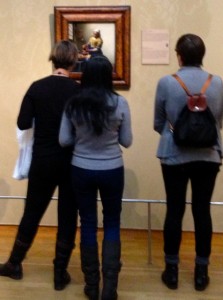You’ve heard of LEDs, the new lighting phenomenon, and, own up, you’re interested. But aren’t they terribly expensive? (They must be, as you keep seeing them on top of the range BMWs and Audis.) And isn’t their light too cold and white? But then again, don’t they use far less energy?
It’s all so confusing. What we need is one big public place where thousands of LEDs (light-emitting diodes) are in use, constantly on, for us to examine and judge for ourselves. Now we have that place. It’s the Rijksmuseum in Amsterdam, which reopens this weekend (April 13, 2013) after a 10 year makeover.
As part of the refit, the Dutch company Philips has installed LEDs to light the 7,500 works of art on display – they include Dutch masters such as Rembrandt and Vermeer. It’s the biggest example in the world of a gallery entirely illuminated with this new lighting technology.
Gallery-goers will know that paintings are usually displayed in rooms with the curtains drawn. So the pieces are rarely if ever shown in natural daylight. Custodians have long known how to arrange the lighting so it shows off the works to best effect, but is it what the artist, often painting in natural light, intended?
Philips addressed this issue in the Rijksmuseum, and claim to have created effects and visual contrasts that closely mimic a colour rendition that comes very close to that seen in daylight. The illumination of each exhibit has been individually tuned and focused to bring out its unique features. Neutral white light has been used to show colours as if they were being viewed in high definition. Pinks, reds, ochres and yellows are said to come out brilliantly; green and blue tones stand out equally well.
LED lighting outlines the visual contrast and relief in the paintings. Particularly so, for example, in paintings with thick impasto – paint applied thickly. Brush and palette knife marks should be more evident. In some of Rembrandt’s work, LED light reveals more of the detail.
The lights give off hardly any heat, and no harmful UV beams, which might damage the artworks. LEDs emit light in a specific direction rather than radiating it outward indiscriminately, which wastes energy. They also absorb back what little heat they produce, leaving the LED itself cool to the touch. LEDs also have a longer life span and require less maintenance than halogen lighting, which is more commonly used in museums. And curators will be able to dim or raise lights individually, through a tablet.
As well as the museum’s artworks, LEDs will also light the Rijksmuseum’s public spaces – the shop, the atriums, the restaurant and the outdoor area and building façade.
What does a sophisticated lighting setup in one of the world’s most prestigious galleries mean to a homeowner thinking of changing some light bulbs? For one thing, it’s the same technology. The LEDs you can buy may be less high-tech and expensive, but they perform essentially the same function.
A good case can be made to fit LEDs in the home. I took this from the FAQs section of the Simple Lighting Company. LEDs can replace almost any current lightbulb, and they have these clear advantages. They light up to their full brightness in microseconds, producing clear-cut beams of light suitable for any application. There are fewer complaints about the weak or cold quality of LED light, now. New models are said to match halogens for colour.
LEDs, with no filament to break or burn out, can last for 10,000 hours and more, between ten to 25 times longer than hooligan and other incandescent light bulbs.
Incandescent bulbs produce light by heating a filament of tungsten metal until it is white hot. Halogen bulbs last longer and also burn hotter than conventional incandescent bulbs, making them more efficient. Compact fluorescent lamps (CFLs) create light through a different mechanism, making them between 67 percent and 80 percent more energy-efficient than incandescent bulbs.
A big selling point of LEDs is that they are much more energy efficient than the above lights. An incandescent light bulb loses 80 percent of its energy as heat, leaving only 20 percent for light. This is reversed with LED bulbs. They lose 20 percent of their energy as heat.
A typical 35W halogen replacement LED will use as little as 4W, and considerably less than the 10W or so a CFL would use to produce the same level of light. Homeowners changing dozens of halogen bulbs could make savings of hundreds of pounds a year.
Despite usually costing more than six times as much as halogens, the payback for LEDs can come quickly. The Energy Saving Trust estimates people prepared to pay the higher up-front cost, could make a return on their investment within a couple of years.
Adam Vaughan, who wrote a piece on LEDs in the Guardian in June 2012, produced a fascinating calculation of the possible savings a householder could make by replacing conventional bulbs with LEDs.
Using 40 LED bulbs in his new-build home for an average of 2.7 hours a day – the Energy Saving Trust’s typical use figure for a bulb in a kitchen or living room – running costs would be £23 annually, compared to £287 for sticking with halogens.
One person made this comment below the article:
“If everyone changes to LED light bulbs we could lose a clutch of nuclear power stations and no one would worry – apart from EDF.”
Try also LED comparison website www.whichledlight.com.

